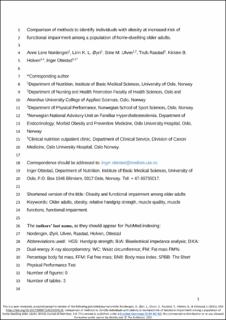| dc.contributor.author | Nordengen, Anne Lene | |
| dc.contributor.author | Øyri, Linn Kristin Lie | |
| dc.contributor.author | Ulven, Stine Marie | |
| dc.contributor.author | Raastad, Truls | |
| dc.contributor.author | Holven, Kirsten Bjørklund | |
| dc.contributor.author | Ottestad, Inger Olaug | |
| dc.coverage.spatial | Norway | en_US |
| dc.date.accessioned | 2022-03-24T08:44:43Z | |
| dc.date.available | 2022-03-24T08:44:43Z | |
| dc.date.created | 2021-11-16T13:35:32Z | |
| dc.date.issued | 2021-11-09 | |
| dc.identifier.citation | British Journal of Nutrition. 2021, . | en_US |
| dc.identifier.issn | 0007-1145 | |
| dc.identifier.issn | 1475-2662 | |
| dc.identifier.uri | https://hdl.handle.net/11250/2987227 | |
| dc.description.abstract | Obesity is associated with increased muscle mass and muscle strength. Methods taking into account the total body mass to reveal obese older individuals at increased risk of functional impairment are needed. Therefore, we aimed to detect methods to identify obese older adults at increased risk of functional impairment. Home-dwelling older adults (n 417, ≥ 70 years of age) were included in this cross-sectional study. Sex-specific cut-off points for two obesity phenotypes (waist circumference (WC) and body fat mass (FM %)) were used to divide women and men into obese and non-obese groups, and within-sex comparisons were performed. Obese women and men, classified by both phenotypes, had similar absolute handgrip strength (HGS) but lower relative HGS (HGS/total body mass) (P < 0·001) than non-obese women and men, respectively. Women with increased WC and FM %, and men with increased WC had higher appendicular skeletal muscle mass (P < 0·001), lower muscle quality (HGS/upper appendicular muscle mass) (P < 0·001), and spent longer time on the stair climb test and the repeated sit-to-stand test (P < 0·05) than non-obese women and men, respectively. Absolute muscle strength was not able to discriminate between obese and non-obese older adults. However, relative muscle strength in particular, but also muscle quality and physical performance tests, where the total body mass was taken into account or served as an extra load, identified obese older adults at increased risk of functional impairment. Prospective studies are needed to determine clinically relevant cut-off points for relative HGS in particular. | en_US |
| dc.description.sponsorship | The present study was supported by the Research Council of Norway (Grant number 225258/E40), Oslo and Akershus University College of Applied Sciences, University of Oslo, Throne Holst Foundation for Nutrition Research and TINE SA. | en_US |
| dc.language.iso | eng | en_US |
| dc.publisher | Cambridge University Press | en_US |
| dc.relation.ispartofseries | British Journal of Nutrition; | |
| dc.rights | Attribution-NonCommercial-NoDerivatives 4.0 Internasjonal | * |
| dc.rights.uri | http://creativecommons.org/licenses/by-nc-nd/4.0/deed.no | * |
| dc.subject | Older adults | en_US |
| dc.subject | Obesity | en_US |
| dc.subject | Relative handgrip strength | en_US |
| dc.subject | Muscle quality | en_US |
| dc.subject | Muscle functions | en_US |
| dc.subject | Functional impairments | en_US |
| dc.title | Comparison of methods to identify individuals with obesity at increased risk of functional impairment among a population of home-dwelling older adults | en_US |
| dc.type | Peer reviewed | en_US |
| dc.type | Journal article | en_US |
| dc.description.version | acceptedVersion | en_US |
| dc.rights.holder | © The Author(s), 2021 | en_US |
| cristin.ispublished | true | |
| cristin.fulltext | postprint | |
| cristin.qualitycode | 2 | |
| dc.identifier.doi | https://doi.org/10.1017/S0007114521004128 | |
| dc.identifier.cristin | 1955150 | |
| dc.source.journal | British Journal of Nutrition | en_US |
| dc.source.pagenumber | 20 | en_US |
| dc.relation.project | Norges forskningsråd: 225258 | en_US |

